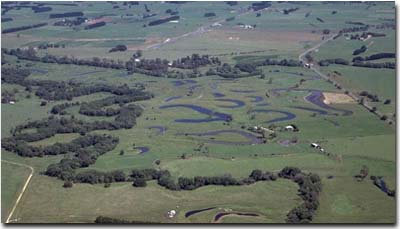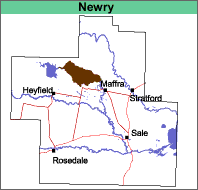Newry (Ne)
Geology
Recent (contemporary) sediments from the Macalister River.
Landform
Flood plain. Numerous abandoned river channels, flanked by natural levees, are a feature of this map unit.
An interactive visualisation of the landscape in the Newry mapping unit is provided here. Zooming and panning functionality is provided as well as the ability to click on icons to provide further information about the landscape (e.g. soils, geology) as well as access other panoramas in the study area.
Photo | Panoroma | Information | Soil pit | Video |
NOTE: Use the '?' icon, inside the panorama, for help with navigation controls. To zoom in use the mouse's 'scroll wheel' (if you have one) or the + and - keys. To explore the landscape, click and hold the left mouse button on the landscape and move the mouse left, right, up or down or use cursor keys.
The interactive landscapes is 28 MB in size, this might take some time to automatically download if you're using a slow internet connection.
Original Vegetation
The original vegetation has been described as riverine scrubs and swamps as well as treeless grasslands (Lunt, 1997). A few remnant red gum (Eucalyptus tereticornis) remain.
Previous Maps and Reports
Aldrick et al. (1992) mapped the area as Maffra 1 which includes the Thomson and Newry map units of this report.
Soils
Apart from the abandoned channels, the surface soils are deep very dark fine sandy clay loams to silty clay loams. The subsoils are similar in texture but tend to be browner and lighter in colour. On the levies of the abandoned channels the overall soil profile textures are generally sandier (fine sandy loams). The Newry map unit is arbitrarily separated from the Thomson map unit because of the number of abandoned channels and its overall apparent lighter soil texture. The soils are generally classified as Black Dermosols using the Australian Soil Classification.
Chemical and Physical Analysis
Soil Pit Site GP73 is located on this map unit and is described below. In common with the similar Thomson map unit, the pH of the surface soil is between 5.5 and 6.0 and becomes slightly alkaline with depth. As the Newry map unit is similar to the Thomson map unit, all of the earlier site data relating to these two units are aggregated under the Thomson map unit.
GP73. Soil Pit Site (Sargeant and Imhof, 2000)
Depth cm | Texture | pH | EC dS/m | Cl % | Nitrogen % | Carbon % | Ca meq% | Mg meq% | K meq% | Na meq% | H meq% | ESP % | Gravel % | Coarse sand % | Fine sand % | Silt % | Clay % | LAT % |
0-15 | FSCL | 5.6 | 0.39 | 0.42 | 4.5 | 13.0 | 3.6 | 1.4 | 0.2 | 3 | 25 | 36 | 27 | 2 | ||||
15-35 | FSCL | 5.6 | 0.07 | 0.19 | 3.0 | 8.5 | 2.7 | 0.32 | 0.3 | 1 | 28 | 34 | 30 | 1 | ||||
35-90 | FSCL | 6.6 | <0.05 | 7.1 | 5.0 | 0.13 | 0.2 | 2 | 3 | 33 | 35 | 27 | 1 | |||||
90+ | ZCL | 7.9 | 0.06 | 6.4 | 6.6 | 0.13 | 0.8 | 6 | 1 | 29 | 40 | 28 | 1 |
The following abbreviations are used to describe field texture: S - sand; LS - loamy sand; ClS - clayey sand; SL - sandy loam; L - loam; CL - clay loam; SCL - sandy clay loam; SC - sandy clay; FSCL - fine sandy clay loam; FSC - fine sandy clay; LC - light clay; MC - medium clay; HC - heavy clay; GR - gravel; ZL - silty loam; ZCL - silty clay loam; ZLC - silty light clay; ZMC - silty medium clay.
Other symbols include: pH - analysed in water; EC - electrical conductivity; Cl - chloride; Ca - exchangeable calcium; Mg - exchangeable magnesium, K - exchangeable potassium; Na - exchangeable sodium; H - exchangeable hydrogen; ESP - exchangeable sodium percentage.
For Soil Pit Sites (Sargeant and Imhof, 2000) exchangeable cations have been determined using Gilman method (where pH >7) and Tucker method (pH <7). Exchangeable Sodium % (ESP) has been calculated here as the percentage of sodium in relation to the sum of the exchangeable basic cations.
Land Use
The soils have a favourable soil structure, are very permeable and highly suited to irrigation. Because they are so permeable, some of the water applied during flood irrigation may penetrate below the root zone. This water is then unavailable to plants and may add to the regional watertable. For these reasons, spray irrigation may be the best way of irrigating these soils.
Most of the soils are used for pasture production but some lucerne and row crops are grown. The likelihood of flooding could be a problem for vegetable cropping.
Flood Risk
Probably 1 in 10 years.
 Remnants of former courses of the Macalister River (forming ox bow lakes). Note the current tree-lined course of the Macalister River. |  |


